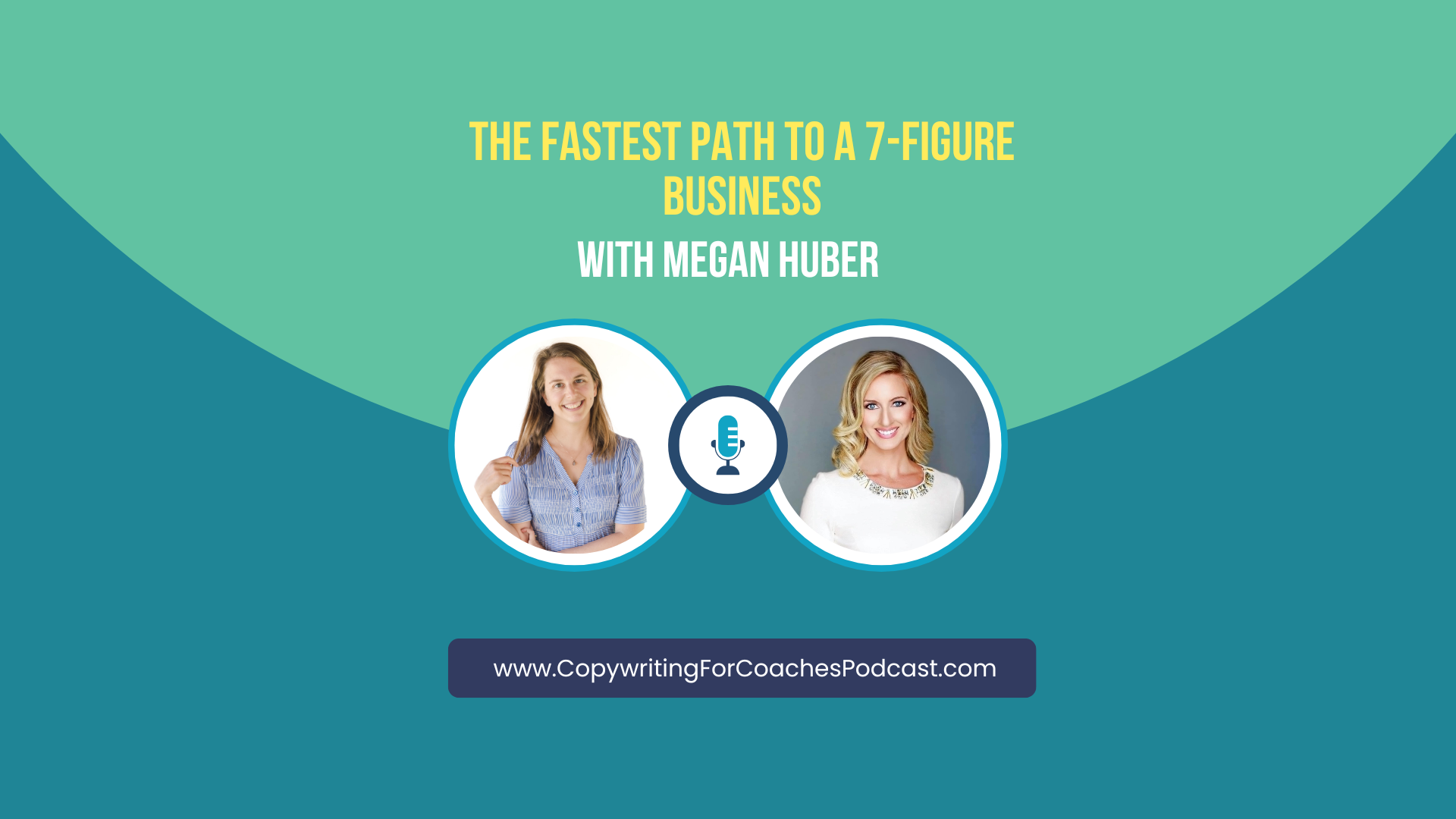Is the urgency and scarcity hype just manipulative marketing? We are deep diving into this debate with perspectives on both sides, specific examples, as well as bringing in the psychology and the hard data on when and whether it works.
This episode is inspired by a Facebook post I made that got a lot of passionate responses. I asked my Facebook audience “What do you think about the use of HONEST urgency and scarcity in your marketing?” and you all had some thoughts. I got a ton of responses and figured this needed to be a podcast episode in and of itself. I wanted to explore if and how we can use urgency and scarcity without compromising integrity.
First, let me emphasize for clarity that this conversation is about honest urgency and scarcity. Obviously, if it’s false urgency or fake scarcity—that’s NOT okay. Ever. If your countdown timer ends, and the price doesn’t go up, that’s not cool. If you say it’s a live webinar, you better show up live. If you’re offering special, limited time bonuses…you need to honor that they are indeed for only a limited time. For example, “Sign up by midnight tonight to get these exclusive bonuses!” means that those same bonuses cannot still be available the next day.
This is something that should go without saying, but I do want to acknowledge these tactics that we have all seen or experienced if you have been in the internet marketing space for any length of time. Now, let’s discuss both the ethics and psychology behind these tactics. We’ll also explore whether and how they can be used with integrity.
My goal is to provide you with the data, and both sides of the story, so that you can make an informed decision that feels good to YOU.
Using Urgency And Scarcity Techniques Ethically
I got 24 responses affirming that urgency and scarcity techniques are ethical, 2 responses that they are a hard no…and, because it’s the internet, there were also a handful that did not understand the question. To be clear, if it’s false urgency or scarcity that’s not actually legitimate…of course, it’s not okay! My question assumes that the statement is honest. If it’s honest, is it still a problem to use? That’s what we’re exploring today
First, I want to highlight two thoughtful responses that got to the heart of my question:
- This is a common technique by major corporations: “I think it’s interesting when people have negative thoughts about this. I get it and for sure some use this in an unethical or misleading way. But it seems like we only apply this standard to small online businesses. Major corporations use this ALL.THE.TIME. and we don’t get mad at them for it. Maybe it’s a sale, or a limited-time discount, or get x if you buy y by a certain date.”
*I also want to note that just because it is a common technique, does not necessarily mean that it’s okay. I am just laying out the facts here so that you can arrive at your own informed decision.
2. It’s smart and helpful: “Truthfully, it’s smart business. Sure, in an ideal world you wouldn’t need to do any of that to get people to buy. But even the best offer can be aided by a little bit of urgency and/or scarcity. It helps the buyer focus and make a decision rather than being distracted by other things or hemming and hawing. I also think that when you do this WELL, it feels good for both the buyer and seller. The buyer wants to feel like they got a good deal. If done poorly, you leave people feeling manipulated (which is NOT what you want to go for).”
Why Business Owners Use Urgency And Scarcity Techniques
Out of the 24 responses supporting the use of urgency and scarcity tactics, I identified three main categories:
-
It helps people make a decision
Inviting people to make a decision about working with you at a specific time can be very effective. It prompts individuals to make a choice, whether positive or negative. If your offer genuinely includes elements of scarcity and urgency, it’s important to communicate these aspects to your audience; otherwise, you risk missing the opportunity to serve them effectively.
Articulating the potential costs of inaction—such as delaying solutions or missing out on desired outcomes—can help people overcome their own hesitations and fears about taking action and investing in themselves. If conveying urgency helps them see the benefits of acting now rather than later, it is beneficial.
Forbes agrees that it encourages “customers to make a decision quicker but in a gentle way. It doesn’t scream ‘buy now.’ It says, ‘better today than tomorrow.’”
2. It communicates the facts about our legitimate limitations
For instance, if you’re running a live course with a set number of spots and a specific start date, it’s not about creating artificial scarcity—it’s about being honest about the very real constraints.
Sharing facts such as “Doors close on X date” or “Only ten spots available” helps set clear expectations. If there’s genuine urgency, like “The live round starts on MONDAY” or only ten places are left, it serves your audience to communicate this effectively.
3. It supports neurodiverse thinkers
It supports neurodiverse thinkers, especially those who have ADHD. In their own words, they responded that “I need it. If not my happy little distracted ADHD brain would never take action on the things I really want to do” and “I need a bazillion reminders before a cart closes.”
Why Business Owners DON’T Use Urgency And Scarcity Techniques
Some business owners choose not to use urgency and scarcity techniques, even when these tactics are honest and legitimate, primarily for 2 reasons:
- Mindset Concerns: Some business owners avoid scarcity because they feel that emphasizing scarcity creates a negative atmosphere and can lead to a “low vibe” approach. They prefer to encourage an abundance mindset, focusing on urgency rather than creating a sense of scarcity.
- Client Decision-Making: Others avoid scarcity because they want clients to make decisions based on confidence and readiness, not fear of missing out. They prefer clients who seek their services proactively, with a clear understanding of the value and results they can provide. Scarcity, in their view, could attract clients who are reactive rather than prepared and committed.
How To Create Urgency and Scarcity In Marketing
Urgency and scarcity are often lumped together. However, from my findings I am about to share with you, there are some important distinctions. Let’s talk about it and get into some tangible examples.
Urgency Copywriting Examples
Urgency in marketing refers to creating a sense of immediate action. It pushes customers to make quick decisions to avoid missing out. (There is a whole psychology behind FOMO. Keep reading…)
- Time-Limited Offers that are available for a short period, encouraging immediate action.
- Examples: Flash sales, countdown timers on websites.
- Effectiveness: Studies show that time-limited offers can increase sales significantly. For instance, a countdown timer can boost conversions by as much as 9%. (Source: Adoric)
- Limited-Time Discounts that clearly communicate the end date and terms of the discount.
- Examples: The discount period needs to be short enough to create a sense of urgency but long enough to give customers time to act.
- Effectiveness: Overusing limited-time discounts can lead to customer desensitization.
- Seasonal Promotions that tie promotions to seasonal events to leverage natural buying cycles.
- Examples: Holiday sales, back-to-school promotions. This is something the PR strategist Selena Soo promotes, and it’s something that Apple’s former head of podcasts has recommended as well.
- Effectiveness: Retailers like Amazon use seasonal promotions effectively, driving significant sales during key periods.
Forbes describes urgency this way: “Urgency makes a clear, relevant promise to customers and removes the barriers to purchase for increased sales and increasingly loyal customers.”
Scarcity Copywriting Examples
Scarcity in marketing involves creating limited availability, which can drive demand and urgency.
- Limited Stock highlights low capacity levels to encourage immediate purchase.
- Examples: E-commerce platforms like Amazon showing “Only 3 left in stock.” Event hosts can share how many seats are left at their venue. Group offer leaders who cap their group programs to protect the depth and capacity they can give to their clients can share how many spots are still available. (Again, this only works if the number is truly capped and you share honestly about how many seats are remaining).
- Benefits: This tactic can increase the perceived value and urgency of the .
- Offer Exclusive Access to certain customers, such as members-only sales or VIP access.
- Benefits: Builds a sense of belonging and urgency to join the exclusive group. (Remember when Clubhouse was all the rage because of its exclusivity? You had to be invited to join.)
- Potential Drawbacks: Can alienate non-members if not balanced carefully.
- Product Launch Scarcity uses pre-order limitations or limited edition releases to build anticipation.
- Examples: Tech companies often limit initial stock during new product launches. Apple immediately comes to mind for this.
- Benefits: Drives demand and extensive media coverage.
By understanding and implementing these urgency and scarcity tactics thoughtfully, marketers can effectively drive action and increase sales while maintaining integrity in their marketing practices.
The Psychology Behind Urgency And Scarcity Techniques
There is no doubt that urgency and scarcity influence decision-making and behavior.
Urgency capitalizes on the fear of missing out (FOMO). When faced with a time-sensitive offer or deadline, individuals experience heightened anxiety about potentially missing out on an opportunity. This fear can override rational decision-making processes, pushing people to act quickly to avoid regret. The ticking clock or limited-time offer creates a sense of urgency that compels immediate action, as individuals are driven to secure a deal or benefit before it’s too late.
Scarcity, on the other hand, leverages the principles of limited availability and exclusivity. When an offer or opportunity is presented as rare or in short supply, it becomes more desirable. This scarcity principle taps into our instinctual drive to value and seek out rare items, as they are perceived to be more valuable. The notion that something is “limited edition” or “only a few left” creates a sense of exclusivity, enhancing its allure and increasing its perceived worth.
Together, these psychological principles play on our fears and desires, encouraging quicker decision-making and increasing the perceived value of offers and opportunities.
The Cookie Jar Study
In 1975, a study conducted by three researchers investigated how scarcity affects perceived value using two identical glass jars. One jar contained ten cookies, while the other held only two. Despite the jars being the same and the cookies being identical, participants valued the cookies in the nearly empty jar more highly. This experiment demonstrated that scarcity—having fewer cookies in one jar—enhanced their perceived value, showing how our perception of value can be influenced by the availability of an item. (Source: American Psychological Association)
Urgency And Scarcity Increases Conversion Rates
“Studies have shown that limited time offers can increase the likelihood of customers making a purchase by as much as 33%. This is because customers see the offer as a limited opportunity and feel the need to act quickly in order to take advantage of it.” (Source: Abmatic.ai)
An Experian report found that promotional or emails conveying a sense of urgency had at least 14% higher click-to-open rates, 59% higher transaction-to-click rates, and twice as high transaction rates compared to their average marketing emails.
Experian’s report also noted that by using urgency in their email subject lines, their transaction rates on sales increased 16%. For them, and many others, it’s most effective to mention the discount as well as the time limit in email subject lines. (Source: Experian.com)
Even colors can evoke a feeling of urgency! Use color psychology here to urgency in forms and CTA buttons. Red, orange, and royal blue are the most effective at creating urgency. Royal blue and orange especially help to encourage action. (Source: ChangingMinds.org)
Boost Your Conversions With Ethical Urgency And Scarcity Techniques
Now that you have the data and the different sides of the story, you can make an informed decision that feels good to YOU. Remember, urgency and scarcity are not the only ways to boost conversions. Here are 4 other ways that effective copywriting can maximize conversions.
If you’d like to work together on incorporating urgency and scarcity into your marketing or your launch plan in a way that works for you, I’ve got several ways we can creatively help you achieve your sales goals in integrity. Download my Services Guide to choose the best way to get support for your next launch.




